



















|
 |
|
 |

The Arverni, like their archrivals the Aedui, rely heavily on shock troops, supported by both medium and heavy cavalry. Many of their shock troops throw javelins before a charge, giving them a stronger punch, but they also sometimes employ shieldwalls and phalanxes.
These Arverni units represent warriors that can be raised from Gaul itself and in addition nearby Belgae regional units. Should the Arverni expand into other lands such as Iberia to the south or Germania to the east, the subject peoples could provide regional troop types in addition.
Lugoae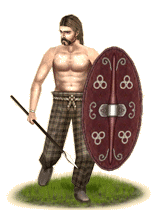 During periods of strife and war, it is necessary sometimes to call upon ordinary citizens to organize as militia. Militia in Celtic societies, called Lugoae (Lug-oo-ay; "Levy Troops"), are farmers, craftsmen, fishermen, and so on, called to brief military service in periods of crisis. They may train a few times a year to fight, and games and sports encourage a decent level of physicality, but they're still only militia, and can only be trusted to do so much.
During periods of strife and war, it is necessary sometimes to call upon ordinary citizens to organize as militia. Militia in Celtic societies, called Lugoae (Lug-oo-ay; "Levy Troops"), are farmers, craftsmen, fishermen, and so on, called to brief military service in periods of crisis. They may train a few times a year to fight, and games and sports encourage a decent level of physicality, but they're still only militia, and can only be trusted to do so much.
Historically, the Celts, being a warrior culture, encouraged their people to engage in sports and games that would increase their physical strength and preparedness for war. This doesn't mean everyone was a warrior though. Those not in the warrior class would be levied into warbands at times, or form their own militias in their towns to defend themselves from outsiders and act as a type of early police force. Their weapons and equipment would be whatever they could afford personally, usually simple hunting implements, such as a hunter's spear, and a shield.
Gaeroas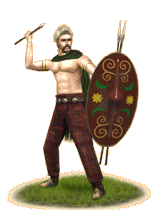 Gaeroas (Guy-rows; "Spear Soldiers") are the file warriors of the tribes of Gaul and Britain. The Gaeroas all utilize well-made long spears, and a few decent javelins, making them both fair melee warriors and impromptu skirmishers. Their versatility, and low relative expense, mean they are a fine warrior band for enterprising warlords looking to expand their lands. They have some experience with combat, but are not yet hardened to battle. However, they are trained well enough to march in a good formation, something actually lost on greater warriors for the Britons. Their longspears may seem a bit unwieldy, but this is likely to help them in combating cavalry and chariot horses as a unit. While unarmored, they have large oval shields, which provides them a good amount of protection. They are fairly well trained with these shields, and they provide a fair amount of protection from ranged attacks, but the lack of armor makes them quite vulnerable to flanking.
Gaeroas (Guy-rows; "Spear Soldiers") are the file warriors of the tribes of Gaul and Britain. The Gaeroas all utilize well-made long spears, and a few decent javelins, making them both fair melee warriors and impromptu skirmishers. Their versatility, and low relative expense, mean they are a fine warrior band for enterprising warlords looking to expand their lands. They have some experience with combat, but are not yet hardened to battle. However, they are trained well enough to march in a good formation, something actually lost on greater warriors for the Britons. Their longspears may seem a bit unwieldy, but this is likely to help them in combating cavalry and chariot horses as a unit. While unarmored, they have large oval shields, which provides them a good amount of protection. They are fairly well trained with these shields, and they provide a fair amount of protection from ranged attacks, but the lack of armor makes them quite vulnerable to flanking.
Historically, spearmen in Britain and Gaul would have been the young to middle-age warriors, who had not risen greatly in prestige, or who had chosen to continue to fight as a lower warrior. They would use well-made, but not truly exceptional spears, and javelins for skirmishing. This allowed their most basic warriors to perform two duties, and allocate other soldiers to more specialized positions. Their equipment would be self maintained, and they would be expected to keep their weapons and shield in good condition. They likely paid for their own equipment, but spears and javelins are relatively cheap, the most expensive part of their equipment was likely the shield. These warriors represent the most basic professional warriors of almost all of the aforementioned tribes. They would be highly viable for the warchief who couldn't afford to bring in many swords or other weapons for his tribe.
Gaelaiche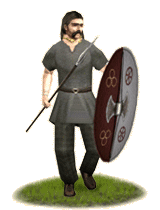 Celtic warbands have always largely relied on spears. The Gaelaiche (Guy-latch; "Spear-Warriors") are the lightest members of the Celtic warrior class. They carry cheap equipment; Celtic longspears, javelins, and a shield. However, they have their uses. Their spears are good against horsemen, and can be used to good affect against infantry as well, and their javelins can be used as a fine method to disorient a foe. Experienced spearmen are a great asset to a campaigning Celtic army, and even inexperienced spearmen are generally superior to any early levies that can be produced. The many transalpine Gallic tribes arm themselves in this manner, but also a handful of tribes in southwest Britain also use such armaments and fighting style.
Celtic warbands have always largely relied on spears. The Gaelaiche (Guy-latch; "Spear-Warriors") are the lightest members of the Celtic warrior class. They carry cheap equipment; Celtic longspears, javelins, and a shield. However, they have their uses. Their spears are good against horsemen, and can be used to good affect against infantry as well, and their javelins can be used as a fine method to disorient a foe. Experienced spearmen are a great asset to a campaigning Celtic army, and even inexperienced spearmen are generally superior to any early levies that can be produced. The many transalpine Gallic tribes arm themselves in this manner, but also a handful of tribes in southwest Britain also use such armaments and fighting style.
Historically, Celts always favored spears; they were easy to produce and didn't require much steel. Celtic longspears were of fair quality, with broad, sharp heads that would cause deep, terrible gashes, and could be used as well to bring down horses. They would accompany these weapons with javelins thrown into an enemy position to disorient and kill a few foes. They would probably be mostly the youngest Celtlic warriors, but there wasn't shame in an older, experienced warrior fighting with a spear as well; the spear was a respected weapon in Celtic society.
Botroas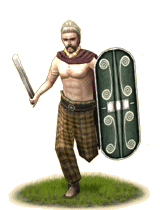 The Botroas (Boat-rows, "Sword Soldiers") are the basic medium infantry of southern Briton and Cisalpine Gaul. They are well trained, with a fair amount of experience, and good quality swords, with javelins to soften an enemy before a charge. Like near all Celtic warriors, they are loyal to a tribal head, who is himself loyal to numerous mounting tiers of nobles, leading to the king. These form the core of the southern armies. Like most Celtic shock infantry, the brunt of their attack is in the charge.
The Botroas (Boat-rows, "Sword Soldiers") are the basic medium infantry of southern Briton and Cisalpine Gaul. They are well trained, with a fair amount of experience, and good quality swords, with javelins to soften an enemy before a charge. Like near all Celtic warriors, they are loyal to a tribal head, who is himself loyal to numerous mounting tiers of nobles, leading to the king. These form the core of the southern armies. Like most Celtic shock infantry, the brunt of their attack is in the charge.
Historically, the Botroas were the younger professional warriors of southern Briton and Cisalpine Gallic tribes. Their lack of armor would leave them vulnerable, but they had great mobility, and their youthfulness included a desire to prove themselves to their people, making them somewhat lacking in fear, or, perhaps, simply more afraid of disgrace than they are of death. The southern Briton warriors looked a great deal like the Cisalpine Gallic swordsmen, and fought in much the same manner.
Iaosatae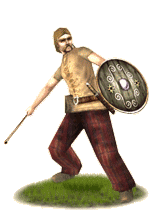 Iaosatae (Yo-sah-tie; "Slingmen") are a varied lot, some young and some old, who've been educated in the art of sling combat. They're quite skilled with their slings, which are truly a deceptively simple weapon. A sling bullet, when slung by a skilled man, will bury itself inside of its target, or break bones. Either way, the one hit is incapacitated or dead. Impressive for what amounts to a leather strip and a rock. The sling is also inexpensive, and with an impressive range. This allows Iaosatae to be both effective and affordable. However, when the distance between them and the enemy is closed, their low expense is quickly made up for in the ease of their breaking and fleeing, as, armed with only light weapons, they are not intended to fight hand-to-hand.
Iaosatae (Yo-sah-tie; "Slingmen") are a varied lot, some young and some old, who've been educated in the art of sling combat. They're quite skilled with their slings, which are truly a deceptively simple weapon. A sling bullet, when slung by a skilled man, will bury itself inside of its target, or break bones. Either way, the one hit is incapacitated or dead. Impressive for what amounts to a leather strip and a rock. The sling is also inexpensive, and with an impressive range. This allows Iaosatae to be both effective and affordable. However, when the distance between them and the enemy is closed, their low expense is quickly made up for in the ease of their breaking and fleeing, as, armed with only light weapons, they are not intended to fight hand-to-hand.
Historically, the Iaosatae would have been a variety of warriors, mostly young men though with little experience in close combat. Few older men continued to use the sling, it would generally be replaced by a spear or sword, but it never fell out of favor with younger men, who could use it for war, games, and hunting. However, their youthfulness, and lack of experience with the grimmer face of combat, makes them prone to run, because, after all, a man fifty meters away with a sword looks a lot different two meters away. Making matters worse for them, their inexperience in close combat means they probably aren't as hardy as other warriors, with more experience fighting in long engagements. Slings were popular with levy warriors in all of Celtic culture, as it didn't take long to train one in the basics, and skilled slingers who went on to become somewhat elite professionals were often well-versed in both sling and short spear combat, meaning an experienced group of Iaosatae would double as impromptu light infantry.
Sotaroas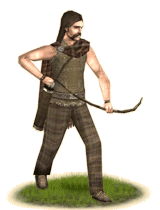 Celtic archers, Sotaroas (Sow-tah-rows, "Bow Soldiers"), while not great or exceptional, are good. They are well trained, disciplined, and can put a fair deal of range behind their attacks. While their arrows aren't too notable, their ability to swiftly pepper an enemy with arrows is always of use. They are not really meant to defeat an enemy force, or even truly damage one, so much as they are meant to irritate and draw attention away from a main force, so it can position itself for flanking. As such, they are good runners, who fire a few volleys as a distraction, and then withdraw to a safe position to hide. If caught in a melee, they would be slaughtered for sure.
Celtic archers, Sotaroas (Sow-tah-rows, "Bow Soldiers"), while not great or exceptional, are good. They are well trained, disciplined, and can put a fair deal of range behind their attacks. While their arrows aren't too notable, their ability to swiftly pepper an enemy with arrows is always of use. They are not really meant to defeat an enemy force, or even truly damage one, so much as they are meant to irritate and draw attention away from a main force, so it can position itself for flanking. As such, they are good runners, who fire a few volleys as a distraction, and then withdraw to a safe position to hide. If caught in a melee, they would be slaughtered for sure.
Historically, archers in Celtic culture had little variety, with only a few truly notable types of archers. They were irritative forces, and intended to soften large enemy forces, but rarely meant to be truly effective in the manner of eastern archers. However, if positioned properly, or experienced enough, they could be truly devastating. Their skill was good, they could fire many volleys swiftly. The Celtic concept of archery was more often to simply blacken the sky with arrows, than it was to fire few, effective volleys. However, their arrows were well made, though not great, and would be capable of puncturing lighter armors, and were quite deadly in their own right. All the same, these men were better off as hunters than field warriors.
Uirodusios (Celtic Naked Spearmen)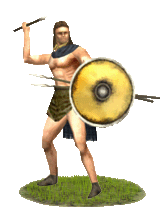 The Uirodusios (Oo-row-doo-see-os; 'Man-Demons') fight in the ancient Celtic style, stripped nude but for his torc, anklets, and bangles, and sometimes a cloak. Though poorly defended, and not nearly as skilled as the Gaesatae mercenaries of Gaul, nor on drugs, they are still formidable and present a frightening visage that unnerves enemies. These are not so much an elite as they are often only somewhat experienced warriors who wish to increase their fame by daring acts of bravery. The Uirodusios (Oo-row-doo-see-os; 'Man-Demons') fight in the ancient Celtic style, stripped nude but for his torc, anklets, and bangles, and sometimes a cloak. Though poorly defended, and not nearly as skilled as the Gaesatae mercenaries of Gaul, nor on drugs, they are still formidable and present a frightening visage that unnerves enemies. These are not so much an elite as they are often only somewhat experienced warriors who wish to increase their fame by daring acts of bravery.
Historically, some Celtic warriors fought stripped nude. This had a few effects; it was unnerving to enemies, inspiring to friends, and also helped increase one's fame; an important matter in Celtic warrior society. The skill of such men would vary depending, logically, on how long they'd been fighting in such a way, but it would likely offer superior mobility compared to alternative methods of combat, allowing them to manuever more swiftly in a melee. Such warriors would stand out in the front of a line to encourage other soldiers and to be the first to engage the enemy.
Bagaudas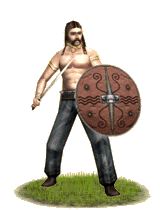 Bagaudas ("Guerilla Fighters") are shortswordsmen from the tribe of the Venetii. The shortsword is a common weapon, essentially a very long knife or dagger, and used by hunters, and carried by many as a form of self defense. Warriors using shortswords are not generally very well trained, if at all. However, they are readily available, cheap, and have a good charge. They lack javelins or other ranged weapons and are extremely vulnerable at range.
Bagaudas ("Guerilla Fighters") are shortswordsmen from the tribe of the Venetii. The shortsword is a common weapon, essentially a very long knife or dagger, and used by hunters, and carried by many as a form of self defense. Warriors using shortswords are not generally very well trained, if at all. However, they are readily available, cheap, and have a good charge. They lack javelins or other ranged weapons and are extremely vulnerable at range.
Historically, the Celts generally favored spears and shortswords for young or inexperienced soldiers. These warriors, with shortswords, were not necessarily that high up in society; the swords were of debatable quality. Many may not even have fought in battle before, just being hunters or young boys called in to fight, or have chosen to go and fight. Light swordsmen in Celtic society were fairly common, and necessary, often, as a bridge between light and medium infantry, when medium infantry was unavailable. They were increasingly more common during the Roman conquests, as the professional armies with longswordsmen had either been bought by the Romans, or turned on one another, leaving the only defense to these young warriors.
Bataroas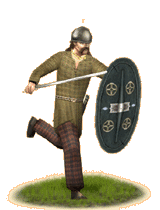 The Bataroas hail from a region the Romans call Transalpine Gaul (Gaul the other side of the Alps). Raised from the Celtic Warrior Class, these Gauls are proud and experienced fighters who often value feats of impetuous valour over acts of more prudent common sense.
The Bataroas hail from a region the Romans call Transalpine Gaul (Gaul the other side of the Alps). Raised from the Celtic Warrior Class, these Gauls are proud and experienced fighters who often value feats of impetuous valour over acts of more prudent common sense.
Despite a Celtic propensity to become easily discouraged when faced with determined opposition and to suffer under a hot sun, an unwary foe will soon be parted with their head. The Celts are large men and the Bataroas use their strength to hurl their spears at great distances before closing with their long swords.
Gaesatae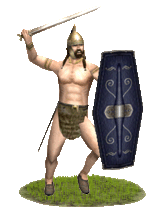 The Gaesatae (Guy-sah-tay; "Spearmen") are easily one of the most fearsome groups of warriors in the known world. They fight stripped bare but for neck torcs and sometimes their shoes or boots. They fight with longswords, but are named for their incredible skill with javelins; they can hurl them unnaturally long distances and deal great damage with them. Their charge is most ferocious though, causing many lines to simply fold and flee. This is not all solely due to skill and strength, though they are experienced and huge, muscular men. They imbibe a chemical before battle making them seemingly impervious to pain. They will fight to the very end, and are very destructive when employed properly.
The Gaesatae (Guy-sah-tay; "Spearmen") are easily one of the most fearsome groups of warriors in the known world. They fight stripped bare but for neck torcs and sometimes their shoes or boots. They fight with longswords, but are named for their incredible skill with javelins; they can hurl them unnaturally long distances and deal great damage with them. Their charge is most ferocious though, causing many lines to simply fold and flee. This is not all solely due to skill and strength, though they are experienced and huge, muscular men. They imbibe a chemical before battle making them seemingly impervious to pain. They will fight to the very end, and are very destructive when employed properly.
Historically, the Gaesatae were Gallic naked religious fanatics. Their skill was a source of terror, and their frightful appearance shook many. Most horrifying, even beyond their size and skill and terrifying cries, was their seeming invincibility. A chemical they used allowed them to brush off and ignore any pain. They were remarked to do things such as rip javelins that had struck them free from their bodies, and hurl them back, and continue to fight with gashes and wounds that would have surely fell a normal man. They were Hannibal's favored Gallic mercenaries, and were used as his personal guards, as they were so devoted and trustworthy, as well as brave and skilled.
Solduros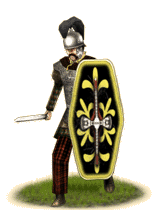 The Solduros (Sul-dur-ohs; "Devoted Ones") are remarkably skilled, fearless elite guards of Celtic nobles. They pledge themselves to eachother and their charge, and fight to the very end. Small in number, they are a remarkable elite, best used to combat an enemy's opposing elite soldiers or heavy troops. They are very well armored and armed, and can surely break many enemies, but they are rare, very expensive, and while their armor and shields are of good quality, they have no form of retaliation at range, and would be too slow to chase off skirmishers or missile troops, and so would need ranged or cavalry support to be used to best effect.
The Solduros (Sul-dur-ohs; "Devoted Ones") are remarkably skilled, fearless elite guards of Celtic nobles. They pledge themselves to eachother and their charge, and fight to the very end. Small in number, they are a remarkable elite, best used to combat an enemy's opposing elite soldiers or heavy troops. They are very well armored and armed, and can surely break many enemies, but they are rare, very expensive, and while their armor and shields are of good quality, they have no form of retaliation at range, and would be too slow to chase off skirmishers or missile troops, and so would need ranged or cavalry support to be used to best effect.
Historically, Celtic nobles surrounded themselves with elite bodyguards of kings, magistrates, and other important nobles and officials, such as high ranking druids. Among them were the "Soldurii", the greatest warriors of the Aquitanni. Each man pledged his life to a fellow of this brotherhood, and the man pledged to would return this pledge; if the one of these two died, and the other did not, the remaining man would take his own life after the battle, for having failed defend him. Julius Caesar noted that no man ever backed down from this duty, and did so fearlessly. Their skill was tremendous; they fought against great odds and could defeat many times their own number. So great and legendary was their name even to their enemies that it can be found having influenced words such as 'soldier' and 'solidarity'.
Golberi Curoas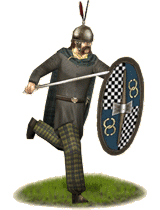 The La Tene Celts were used as mercenaries all over Europe and Africa by the Romans, Carthaginians, other Celts, and various peoples. These men often form the core of a mercenary army, and are usually tough veterans who have seen many different campaigns and have taken pay from many different masters. They are an excellent heavy infantry, well able to deal with most opponents. They are armed with javelins and spears and use these javelins to break up an enemy formation before the charge. As with most Celts, the charge can become disorderly, but it often succeeds in breaking through the enemy line none-the-less. Their name, Curoas (Koo-roo-as) means "Paid Soldiers".
The La Tene Celts were used as mercenaries all over Europe and Africa by the Romans, Carthaginians, other Celts, and various peoples. These men often form the core of a mercenary army, and are usually tough veterans who have seen many different campaigns and have taken pay from many different masters. They are an excellent heavy infantry, well able to deal with most opponents. They are armed with javelins and spears and use these javelins to break up an enemy formation before the charge. As with most Celts, the charge can become disorderly, but it often succeeds in breaking through the enemy line none-the-less. Their name, Curoas (Koo-roo-as) means "Paid Soldiers".
Historically, Celtic mercenaries were used all over the ancient world. Graves and artifacts have been found even into Asia. Celts were rightly famed for their ferocity in battle, as well as a number of innovations in arms and armor development. There were many Celts willing to leave their tribes and serve other masters in exchange for wealth. This made them somewhat untrustworthy, willing to flee if a battle went poorly, as they didn't fight for honor or glory, but money, and money was useless if one was dead. The La Tene Celts actually encompassed a number of sub-cultures, most notably Gaul, but also the Lugians, Belgae, most Britons, and others. This meant that in much of Europe, Celtic warriors were never far away, and so, for the wealthy general, he could have always had at least some heavy infantry on hand.
Enoci Curoas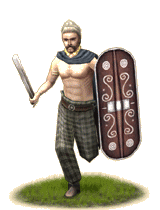 The La Tene Celts were used as mercenaries all over Europe and Africa by the Romans, Carthaginians, other Celts, and various peoples. These men often form the core of a mercenary army, and are usually tough veterans who have seen many different campaigns and have taken pay from many different masters. They are an excellent heavy infantry, well able to deal with most opponents. They are armed with javelins and spears and use these javelins to break up an enemy formation before the charge. As with most Celts, the charge can become disorderly, but it often succeeds in breaking through the enemy line none-the-less. Their name, Curoas (koo-roo-as) means "Paid Soldiers".
The La Tene Celts were used as mercenaries all over Europe and Africa by the Romans, Carthaginians, other Celts, and various peoples. These men often form the core of a mercenary army, and are usually tough veterans who have seen many different campaigns and have taken pay from many different masters. They are an excellent heavy infantry, well able to deal with most opponents. They are armed with javelins and spears and use these javelins to break up an enemy formation before the charge. As with most Celts, the charge can become disorderly, but it often succeeds in breaking through the enemy line none-the-less. Their name, Curoas (koo-roo-as) means "Paid Soldiers".
Historically, Celtic mercenaries were used all over the ancient world. Graves and artifacts have been found even into Asia. Celts were rightly famed for their ferocity in battle, as well as a number of innovations in arms and armor development. There were many Celts willing to leave their tribes and serve other masters in exchange for wealth. This made them somewhat untrustworthy, willing to flee if a battle went poorly, as they didn't fight for honor or glory, but money, and money was useless if one was dead. The La Tene Celts actually encompassed a number of sub-cultures, most notably Gaul, but also the Lugians, Belgae, most Britons, and others. This meant that in much of Europe, Celtic warriors were never far away, and so, for the wealthy general, he could have always had at least some heavy infantry on hand.
Teceitos (Celtic Axemen)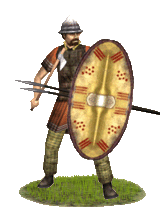 The Teceitos (Tek-ee-tos; Axe Soldiers) are a facet of a Celtic army that is not written about as much as their swords and spears, but many Celtic warriors were buried with axes, particularly in Britain and eastern Europe. The axe is a fine weapon, able to do great damage, even through armor. One can actually strike a man in a mail shirt, not damage the mail itself, but kill the wearer by the sheer amount of blunt trauma dealt to the foe's internal organs. As such, armor stands little chance against these men. They wear leather or padded vests and bronze or iron helmets to help protect themselves. They are light enough to move swiftly over the battlefield, allowing them to flank heavy infantry, and strike them from the sides or flanks. Coupled with their axes and javelins, they are especially valuable at breaking up heavy infantry; they make a great asset to chariots particularly, following the chariots into breaches in the enemy heavy infantry, and cutting open the gaps wider. The Teceitos (Tek-ee-tos; Axe Soldiers) are a facet of a Celtic army that is not written about as much as their swords and spears, but many Celtic warriors were buried with axes, particularly in Britain and eastern Europe. The axe is a fine weapon, able to do great damage, even through armor. One can actually strike a man in a mail shirt, not damage the mail itself, but kill the wearer by the sheer amount of blunt trauma dealt to the foe's internal organs. As such, armor stands little chance against these men. They wear leather or padded vests and bronze or iron helmets to help protect themselves. They are light enough to move swiftly over the battlefield, allowing them to flank heavy infantry, and strike them from the sides or flanks. Coupled with their axes and javelins, they are especially valuable at breaking up heavy infantry; they make a great asset to chariots particularly, following the chariots into breaches in the enemy heavy infantry, and cutting open the gaps wider.
Historically, Celts were, by the late La Tene, mostly recorded using spears and swords. However, in some regions, Britain and Ireland particularly, the axe was still used, and has been found in numerous burials and hordes, and axes are depicted on Caesar's coins of weapons and armor of defeated Gauls. This should not come as a surprise. The axe is easy to make, cost effective, and can be used to defeat armor or shieldwalls. The Celtic axe is not necessarily the largest of axes, but Celtic metalwork is skilled, so their heads are most likely of good quality, and upkeep would be easy for a Celtic warrior, by himself or with attendants. The head would surely keep a good edge, and even without one, a blunt edged axe can still be used to savagely hack a foe apart without the fear of it breaking like a blunted sword.
Neitos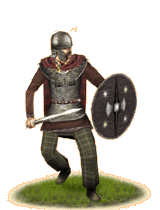 Gallic armies of the late period relied upon the same shock tactics they had employed during earlier times, but the need to combat increasingly better armoured and trained enemies led to the formation of a professional force. Well armored in quality chain, with sturdy shields, and good longswords, the Neitos (Nee-yet-os; "Soldiers") are professional soldiers, and excellently skilled and disciplined when compared to the bulk of light Gallic soldiers. Their charge has great strength, and their skill in close is frightening; they would be capable of fighting hardest where needed.
Gallic armies of the late period relied upon the same shock tactics they had employed during earlier times, but the need to combat increasingly better armoured and trained enemies led to the formation of a professional force. Well armored in quality chain, with sturdy shields, and good longswords, the Neitos (Nee-yet-os; "Soldiers") are professional soldiers, and excellently skilled and disciplined when compared to the bulk of light Gallic soldiers. Their charge has great strength, and their skill in close is frightening; they would be capable of fighting hardest where needed.
Arjos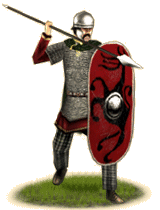 The Arverni ("Superior Ones", home to the famous Vercingetorix) are a large powerful tribe who have become extremely wealthy through trade with the Mediterranean and 'exploitation' of the trade routes North. As such, the Arverni have a large body of Nobles afforded the time and wealth to prepare for battle.
The Arverni ("Superior Ones", home to the famous Vercingetorix) are a large powerful tribe who have become extremely wealthy through trade with the Mediterranean and 'exploitation' of the trade routes North. As such, the Arverni have a large body of Nobles afforded the time and wealth to prepare for battle.
The Arjos ("Nobles") sport the finest equipment available and train daily in its use. Due to their wealth and status they tend not to be as concerned with feats of valor, but instead exhibit greater tenacity in battle.
Though not the equal of the Greeks or Macedonians, the Arjos fight well in phalanx and prove themselves a sturdy force in any battle line.
Leuce Epos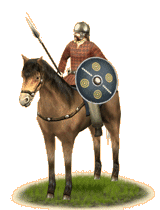 Leuce Epos (Luk Eep-os; "Light Horse") constitute the bulk of Gallic cavalry. Comparatively well-trained to many of their enemies' cavalry, they are invaluable to a Gallic army. They throw javelins at a distance, depleting an enemy before charging with their main spears. They are trained to throw javelins, charge, and withdraw repeatedly, and they do it well. They are so named for their speed, rather than equipment. A bronze helmet, shield, and their weapons may not seem the equipment of any partiuclarly great cavalry, but they are a solid medium cavalry force, capable of running down routers, defeating light cavalry, and skirmishing if necessary.
Leuce Epos (Luk Eep-os; "Light Horse") constitute the bulk of Gallic cavalry. Comparatively well-trained to many of their enemies' cavalry, they are invaluable to a Gallic army. They throw javelins at a distance, depleting an enemy before charging with their main spears. They are trained to throw javelins, charge, and withdraw repeatedly, and they do it well. They are so named for their speed, rather than equipment. A bronze helmet, shield, and their weapons may not seem the equipment of any partiuclarly great cavalry, but they are a solid medium cavalry force, capable of running down routers, defeating light cavalry, and skirmishing if necessary.
Historically, Gauls were rather fond of cavalry in their later years. While Celts were originally more based upon infantry and chariots, and still were built around varying degrees of infantry, the value of extremely mobile cavalry was constantly more apparent. With that in mind, they developed good quality cavalry that could be used as both shock cavalry and ambushers. These cavalry were a large basis of what the Romans employed as their Gallic cavalry auxilia, though a bit heavier than the Gallic originals.
Brihentin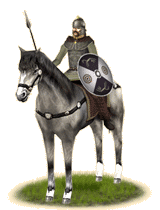 Gallic Brihentin (Bree-hen-ten; Knights) are heavy cavalry. They are used as shock cavalry to break an enemy position and destroy flanks, as well as overrun heavy infantry and slaughter lighter cavalry. Their spears, swords, and chain armor is all of finest quality, and their skill is great, though they are, as any cavalry, vulnerable to long spears and pikes. They can be used to best effect for riding down enemy heavy infantry and defeating light cavalry. Their armor can absorb many blows, and that should allow them to keep fighting.
Gallic Brihentin (Bree-hen-ten; Knights) are heavy cavalry. They are used as shock cavalry to break an enemy position and destroy flanks, as well as overrun heavy infantry and slaughter lighter cavalry. Their spears, swords, and chain armor is all of finest quality, and their skill is great, though they are, as any cavalry, vulnerable to long spears and pikes. They can be used to best effect for riding down enemy heavy infantry and defeating light cavalry. Their armor can absorb many blows, and that should allow them to keep fighting.
Historically, the Gauls employed heavy cavalry as a method of breaking dense enemy formations, and were sometimes employed by Carthage, in addtion to various Gallic chiefs and kings. They were apparently of great enough skill to impress their employers; Hannibal grouped his Gallic heavy cavalry with his Iberian heavy cavalry during his campaign in the Italic peninsula. Such warriors would cost much to outfit, but they would surely be worth everything spent to ensure they had the best possible equipment.
Curepos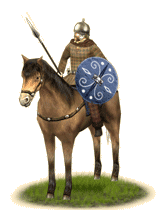 Curepos are mercenary Gallic light cavalry. Comparatively well-trained to many of their enemies' cavalry, they are invaluable to a Gallic army. They throw javelins at a distance, depleting an enemy before charging with their main spears. They are trained to throw javelins, charge, and withdraw repeatedly, and they do it well. They are so named for their speed, rather than equipment. A bronze helmet, shield, and their weapons may not seem the equipment of any partiuclarly great cavalry, but they are a solid medium cavalry force, capable of running down routers, defeating light cavalry, and skirmishing if necessary.
Curepos are mercenary Gallic light cavalry. Comparatively well-trained to many of their enemies' cavalry, they are invaluable to a Gallic army. They throw javelins at a distance, depleting an enemy before charging with their main spears. They are trained to throw javelins, charge, and withdraw repeatedly, and they do it well. They are so named for their speed, rather than equipment. A bronze helmet, shield, and their weapons may not seem the equipment of any partiuclarly great cavalry, but they are a solid medium cavalry force, capable of running down routers, defeating light cavalry, and skirmishing if necessary.
Historically, Gauls were rather fond of cavalry in their later years. While Celts were originally more based upon infantry and chariots, and still were built around varying degrees of infantry, the value of extremely mobile cavalry was constantly more apparent. With that in mind, they developed good quality cavalry that could be used as both shock cavalry and ambushers. These cavalry were a large basis of what the Romans employed as their Gallic cavalry auxilia, though a bit heavier than the Gallic originals.
Gaizoz Alje (Celto-Germanic Spearmen)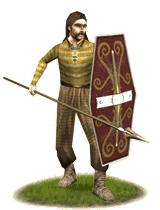 On the borders between Celtic and Germanic territories, the cultures overlap and give rise to troops that are a mesh of both cultures. These spearmen, the Gaizoz Alje ("Foreign Spears") are capable warriors who fight with long shields, javelins, and Celtic longspears that are excellent for killing horses. They throw javelins before charging, and can use their spears to absorb the shock of a cavalry rush. Their skills are a mix of Celtic and Germanic warfare and are a good addition to any army. On the borders between Celtic and Germanic territories, the cultures overlap and give rise to troops that are a mesh of both cultures. These spearmen, the Gaizoz Alje ("Foreign Spears") are capable warriors who fight with long shields, javelins, and Celtic longspears that are excellent for killing horses. They throw javelins before charging, and can use their spears to absorb the shock of a cavalry rush. Their skills are a mix of Celtic and Germanic warfare and are a good addition to any army.
Historically, as Celtic and Germanic cultures fought, traded, and intermarried, their cultures melded, creating unique sub-cultures and mixed tribes, with melds of tactics, weapons, and military philosophies. Such warriors were generally very fierce, and their armies built around infantry. The employ of lengthy spears was common to defeat enemy cavalry, though they could be used to effect against infantry as well. Warriors of this type actually persisted for quite a long time; even up to the fall of Rome, less-Romanized Britons under Anglo-Saxon rule or culture would have been fairly similar troops.
Mori Gaesum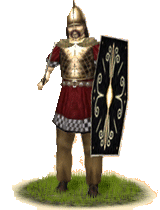 The Mori Gaesum ("Sea Of Spears") is an elite mercenary unit of Helvetii origin. The Helvetii tribes are more known for their fierceness than their unity. As such, much of the great warriors of each tribe sell their services to the highest bidders. Some of these men are used to face Hellenic armies and, consequently, have incorporated some of their enemy's tactics in to their own.
The Mori Gaesum ("Sea Of Spears") is an elite mercenary unit of Helvetii origin. The Helvetii tribes are more known for their fierceness than their unity. As such, much of the great warriors of each tribe sell their services to the highest bidders. Some of these men are used to face Hellenic armies and, consequently, have incorporated some of their enemy's tactics in to their own.
They use the familiar phalanx tactic to engage and tire the enemies before switching to their sword and shield to finish them off. This method, together with their well known fierceness and skill, make them a frightening opponent for any enemy army.
Though not the equal of the Greeks or Macedonians in phalanx warfare, the Mori Gaesum can compensate that with superior swordsmanship, aggressiveness and experience.
Noricene Gaecori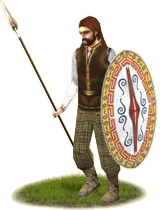 Noricene Gaecorii (Guy-kur-ee-eye; "Spear Troop") are a product of Celtic, Italic, and Hellenistic influences present in Noricum. They are essentially a Celtic warband, but their oval shield is reinforced. These men are semi-professional soldiers, not levies, despite their simple armaments. They are from the mountains, and, as such, are more resilient to the natural elements than most, and are quite hardy. Their throwing spears aren't of the greatest quality, but they can soften an enemy before they charge.
Noricene Gaecorii (Guy-kur-ee-eye; "Spear Troop") are a product of Celtic, Italic, and Hellenistic influences present in Noricum. They are essentially a Celtic warband, but their oval shield is reinforced. These men are semi-professional soldiers, not levies, despite their simple armaments. They are from the mountains, and, as such, are more resilient to the natural elements than most, and are quite hardy. Their throwing spears aren't of the greatest quality, but they can soften an enemy before they charge.
Historically, Noricum was the product of a Celtic culture absorbing many Hellenic and Italic influences. They were very much Celtic, but the clear Hellenic and Italic influences evidenced themselves in the use of various phalanx tactics they used, and linothorax armor, as well as other developments. These warriors were 'basic' soldiers, but comparatively well trained compared to other Celtic warbands. They would be well trained and somewhat disciplined, and capable of softening foes before the actual soldiers engaged them, or engaging lighter enemies by themselves.
Batacorii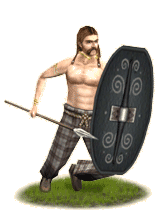 Batacorii are the file warriors of the Belgae, a group of extremely fierce tribes that were highly independent, well trained and experienced in war. Shunning the 'comforts' often afforded the members of the 'civilised' states, they pride themselves on their rugged way of life, their toughness of mind and body and their skill at arms.
Batacorii are the file warriors of the Belgae, a group of extremely fierce tribes that were highly independent, well trained and experienced in war. Shunning the 'comforts' often afforded the members of the 'civilised' states, they pride themselves on their rugged way of life, their toughness of mind and body and their skill at arms.
The Belgae Batacorii utilize well-made spears and a few decent javelins. Extremely fit and experienced in warfare, they make good melee warriors and impromptu skirmishers. Their versatility, and eagerness for battle / low relative expense, mean they are a fine warrior band for enterprising warlords looking to expand their lands. While unarmoured, they have good quality shields and are well trained in using them to fend of attack.
Milnaht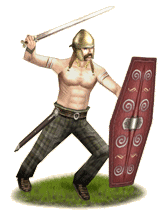 The Milnaht (Mel-not; "Great Men") are a very fierce group of warriors. With lands in the north of Gaul, south of Britain, and middle of Hibernia, the Belgae have spread themselves over a fairly wide area. They are a fair mix of Britons and Gauls, with portions of the more civilized Gallic culture mixed into the more tribal and fierce culture of the Britons. They still wear bronze helmets and sometimes employ bronze weapons as back ups. However, they use a great deal of iron in swords, spear, javelin and arrow heads, and chain shirts worn by their nobles. The professional warriors of the Belgae are bare chested warriors with a long, bronze rimmed shield, and bronze helmet, and sometimes painted with the elaborate designs popular to the Britons. Their ferocity and skill with their swords and shields make them capable of standing against slightly heavier warriors. They are also capable of sapping, and have a penchant for undermining walls, making them valuable to any army of Britons marching into Europe, where they are bound to encounter stone fortifications. If the Gauls or a tribe of Britons ever managed to incorporate Belgae regions into their lands, they would undoubtedly try and use them in battle. Aside from their charge, they form an impressive, tight 'shieldwall' type of formation, to resist opposing charges.
The Milnaht (Mel-not; "Great Men") are a very fierce group of warriors. With lands in the north of Gaul, south of Britain, and middle of Hibernia, the Belgae have spread themselves over a fairly wide area. They are a fair mix of Britons and Gauls, with portions of the more civilized Gallic culture mixed into the more tribal and fierce culture of the Britons. They still wear bronze helmets and sometimes employ bronze weapons as back ups. However, they use a great deal of iron in swords, spear, javelin and arrow heads, and chain shirts worn by their nobles. The professional warriors of the Belgae are bare chested warriors with a long, bronze rimmed shield, and bronze helmet, and sometimes painted with the elaborate designs popular to the Britons. Their ferocity and skill with their swords and shields make them capable of standing against slightly heavier warriors. They are also capable of sapping, and have a penchant for undermining walls, making them valuable to any army of Britons marching into Europe, where they are bound to encounter stone fortifications. If the Gauls or a tribe of Britons ever managed to incorporate Belgae regions into their lands, they would undoubtedly try and use them in battle. Aside from their charge, they form an impressive, tight 'shieldwall' type of formation, to resist opposing charges.
Historically, the Belgae were a number of extremely fierce tribes that were highly indepedent. However, they were fairly well trained, their violent behavior toward most outsiders forced them to learn tactics and the finer points of warfare to defend themselves from their many, many enemies. The lower warriors would fight bare chested almost always, even in winter, though they actually wore cloaks to the point of the battle, then would toss them aside to fight. Among the Belgic tribes were the Nervii, easily among the most fierce of all the Celtic peoples, and many of the first Celtic invaders into Ireland. The Belgae fought using three main manners, their fierce forward charge, their skilled and methodic ambushes, and their hit-and-run skirmish tactics. They were also skilled sappers and tacticians, but above all remembered is the charge and shieldwall. The Belgae could break near any enemy with a fierce charge, and if they could not, their good skill with their weapons and shields allowed them the power to stand and fight, and their wall could absorb most infantry charges with ease.
Taramannos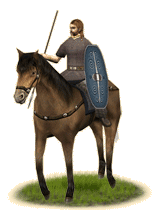 The Taramonnos (Tar-ay-mon-os; "Thunderers") were the light cavalry of the Belgae. Devoted to the thunder god, Tarannis, they were said to replicate the sound of thunder in their attacks; a somewhat disturbing trait at least. They are lighter than the horsemen of the Gauls, but fight in a similar manner. They throw javelins and use charge and retreat tactics to weaken and eventually break an enemy, in concert with infantry charges, and harrying tactics to weaken marching foes. Depicted on their shields are symbols of their chosen patron, Tarannis, the symbol of thunder and lightning.
The Taramonnos (Tar-ay-mon-os; "Thunderers") were the light cavalry of the Belgae. Devoted to the thunder god, Tarannis, they were said to replicate the sound of thunder in their attacks; a somewhat disturbing trait at least. They are lighter than the horsemen of the Gauls, but fight in a similar manner. They throw javelins and use charge and retreat tactics to weaken and eventually break an enemy, in concert with infantry charges, and harrying tactics to weaken marching foes. Depicted on their shields are symbols of their chosen patron, Tarannis, the symbol of thunder and lightning.
Historically, the Belgae were a number of extremely fierce tribes that were highly indepedent. However, they were fairly well trained, their violent behavior toward most outsiders forced them to learn tactics and the finer points of warfare to defend themselves from their many, many enemies. The lower warriors would fight bare chested almost always, even in winter, though they actually wore cloaks to the point of the battle, then would toss them aside to fight. Among the Belgic tribes were the Nervii, easily among the most fierce of all the Celtic peoples, and many of the first Celtic invaders into Ireland. The Belgae fought using three main manners, their fierce forward charge, their skilled and methodic ambushes, and their hit-and-run skirmish tactics. They were also skilled sappers and tacticians, but above all remembered is the charge and shieldwall. The Belgae could break near any enemy with a fierce charge, and if they could not, their good skill with their weapons and shields allowed them the power to stand and fight, and their wall could absorb most infantry charges with ease.
Remi Mairepos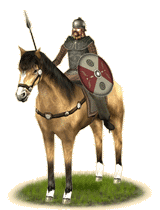 The Remi were famed horsemen. Brave, unrelenting, and powerful, their cavalry could ride over opposition, and rout numerically superior enemies; their Mairepos (Mar-ep-os; "Great Horses") were able to smash infantry and their armor, shields, and weapons were of good quality, and their skill was unquestionable. They were superior to other Gallic heavy cavalry, but they hailed only from one tribe, and like any cavalry would be vulnerable to longspears and pikes. All the same, properly employed, they could turn a losing situation into a victory.
The Remi were famed horsemen. Brave, unrelenting, and powerful, their cavalry could ride over opposition, and rout numerically superior enemies; their Mairepos (Mar-ep-os; "Great Horses") were able to smash infantry and their armor, shields, and weapons were of good quality, and their skill was unquestionable. They were superior to other Gallic heavy cavalry, but they hailed only from one tribe, and like any cavalry would be vulnerable to longspears and pikes. All the same, properly employed, they could turn a losing situation into a victory.
Historically, the Remi were a feared Belgae tribe. Their cavalry was of great skill compared to that of the Gauls, and they made good account of themselves in all battles where they were present, regardless of the outcome. They acted bravely, and performed many actions that would have been suicidal if not for their training and skill, and probably also their fearsome reputation that would weaken the resolve of their foes.
|
 |
|
 |






















|